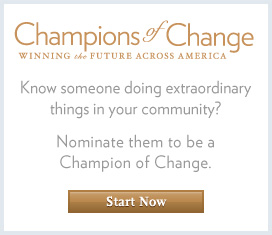Champions of Change Blog
One Shoe at a Time
Posted by on September 20, 2012 at 2:14 PM EDT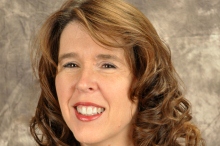 Susan Hennum is being honored as a Champion of Change for her Kiwanis International service.
Susan Hennum is being honored as a Champion of Change for her Kiwanis International service.
It started as a simple program that I could bring to my elementary students—as easy as taking one step at a time but in our case, one shoe at a time.
My work with Shoes for Orphan Souls, a Buckner International Program, started in 2000 when I was the Texas-Oklahoma District Chair for K-Kids, which is a Kiwanis-sponsored elementary school program that teaches leadership and empowers children to serve their communities. As a member of the Kiwanis Club of Garland, Texas, and an advisor to a K-Kids club, I wanted to find a service project that would not only be easy for the kids to participate in, but one that they could feel good about and know they had made a difference in the life of someone else. We asked our adult Kiwanis members to bring new shoes to our conventions. In turn, the K-Kids clubs would write letters to the children in the orphanages for us to stuff in the shoes. It was an easy sell for the students.
The first year, we partnered with our middle school Builders Clubs and encouraged the students to write letters while the adult Kiwanis clubs provided the shoes. We collected more than 1,000 pairs the first year. We continued to collect shoes at all our events, and I quickly became known as the “Shoe Lady.” We had the local high school’s Key Club—another Kiwanis- sponsored leadership program—come to our events and sort the shoes and tie them together. It was a great way for students of all ages to work together with their sponsoring adult clubs. Many of our Key Clubs went to the location where Buckner had their first collection point and helped to sort and tie shoes.
In 2003, while serving as Kiwanis International chairman for the K-Kids Committee, I asked Kiwanis members who served as district administrators all over the world to come together at the Kiwanis International convention in Indianapolis and bring new shoes. The goal was to show everyone that Shoes for Orphan Souls was a great project to partner with your sponsored programs. What a unique opportunity for student clubs all over the world to work on the same program and help the less fortunate children get their first pair of new shoes. The goal was for the Kiwanis clubs to donate the new shoes and for the K-Kids to write letters to children in the orphanage. We collected 20,000 pairs of shoes that year!
I have since encouraged the students to collect shoes over the years, and after being elected governor of the Kiwanis Texas-Oklahoma District, I took this opportunity to institute the Shoe Project as my governor’s project. I am pleased to say that we collected more than 5,000 pairs of shoes this year.
I understand what it could be like not to have new shoes. I am very blessed to have been a private adoption. I can't imagine being in an orphanage and relying on others to supply you with clothes and shoes. I think this is why I love this program so much. We have had a wonderful time this year collecting shoes and rain boots for the program. It is just a simple program—starting with one step or one shoe at a time!
Susan Hennum is a member of Kiwanis International
Learn more about ServiceSpreading the Word About Tetanus
Posted by on September 20, 2012 at 1:21 PM EDT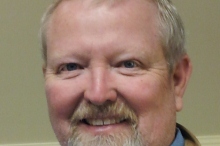 John Mayfield is being honored as a Champion of Change for his Kiwanis International service.
John Mayfield is being honored as a Champion of Change for his Kiwanis International service.
About 25 years ago, my life turned around. I once battled drug and alcohol addiction. I often didn’t take advantage of positive opportunities and suffered consequences for my actions. I knew I needed to change, so I started inviting God into my life and asking his will for me. He gave me the knowledge about how to change. I got sober, and everything just fell into place.
Ever since, I’ve found fulfillment through philanthropy. I live in Ashland City, Tennessee, and I’m proud to support local charities and causes. For instance, I own Mayfield’s Book Store, where all proceeds from the used books go to support the John E. Mayfield Charitable Foundation. Students at Nashville State Community College study and conduct research at the John E. Mayfield Library. For the past decade, graduating 4-H members have been named John E. Mayfield Scholars.
I’m also a member of my local Kiwanis club. My father had been a Kiwanian before me, but I didn’t know much about Kiwanis International as an organization when I joined in 2007. It ended up changing my life. One big reason is the unbelievable people I’ve met. With Kiwanis, a great example of good people working for a good cause is The Eliminate Project, which is raising money for the vaccines, supplies and education that will help eliminate maternal and neonatal tetanus among some of the world’s poorest and hardest-to-reach families.
When I gave a donation to the campaign, I was thinking, “How can I change the world?” With just me, it wouldn’t go very far. But with Kiwanis, UNICEF and country governments working together, it can.
Last November, I was honored to be part of a Kiwanis International delegation that traveled to Sierra Leone to witness MNT elimination efforts in hard-to-reach rural villages. In the town of Bo, we visited a pilot program at a local school where adolescent girls received their tetanus vaccinations. I held four girls’ hands while they got their shots. Some were scared and others were brave, but all of them realized the importance of this vaccine. That experience will stay with me for the rest of my life.
Now I’m committed to telling that story. I talk to Kiwanis clubs in communities outside my own, spreading the word about tetanus, how it can be stopped and how The Eliminate Project is a great opportunity for people like us to change the world. I can honestly say that the campaign has been another of those life-changing experiences I’ve been so lucky to have.
I’m thrilled to receive the Champions for Change award. It’s an honor to be recognized.
John Mayfield is the Charter President of the Cheatham County Kiwanis Club and current lieutenant governor for Division 14 of the Kentucky-Tennessee District of Kiwanis International
Learn more about ServiceGlobal Responsibility and Impact
Posted by on September 20, 2012 at 1:05 PM EDT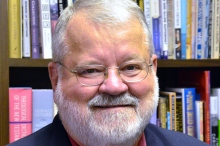 Robert L. Moore is being honored as a Champion of Change for his Kiwanis International service.
Robert L. Moore is being honored as a Champion of Change for his Kiwanis International service.
Though I’d been a Kiwanian since 1968, I did not fully realize the global impact we could make until I joined a fact-finding trip to Ghana. That trip changed my life.
In 1993, Kiwanis International decided to expand from local and regional service initiatives to our first Worldwide Service Project. I was selected to help determine a world health problem that could be eradicated for a known cost, in a known time frame, that Kiwanians and their clubs across the globe could embrace and eliminate. We chose iodine deficiency disorders (IDD), and we chose to partner with UNICEF to raise funds and awareness of this global issue. The absence of iodine in the diet often results in mental disability.
One of several fact-finding trips was to Ghana. For me, the most difficult aspect of that trip was meeting with village officials and children who were affected by the lack of iodine in their diets. They knew they had a problem and thought we’d come with the cure; we had to tell them we did not, but we would be back. Thanks to the successful campaign, the people of Ghana are moving toward eliminating IDD. I remained on the IDD team, working with UNICEF, UNICEF-USA and USAID, testifying before a congressional committee about the dire needs and requesting funds for the project. I later served on a panel at the U.N. Summit for Children discussing the effort to eliminate IDD.
Because of the Ghana trip, I felt the need to move beyond my local Kiwanis club in Venice and my region of Florida to serve on the Kiwanis International Board, which I did for 10 years before being elected as president for 2003–2004. Visiting more than 35 countries over this time reinforced my conviction that we all have a responsibility to improve the lives of children no matter where in the world they live—the way to do it is through collaboration.
As a result of Kiwanis’ involvement in the IDD project, I represented Kiwanis in a meeting at the Gates Foundation to form an organization to work in the area of micronutrients. I continue to work in the field of micronutrients by serving on the Micronutrient Initiative Board of Directors, currently as chairman. The Ghana experience changed my life.
Robert L. Moore is a practicing attorney in Venice, Florida
Learn more about ServiceMaking a Dream Reality
Posted by on September 20, 2012 at 12:36 PM EDT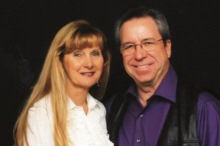 Danny and Pam Spitler are being honored as a Champions of Change for their service to the Kiwanis International.
Danny and Pam Spitler are being honored as a Champions of Change for their service to the Kiwanis International.
Pam and I are certainly honored to be recognized as Champions of Change. Our lives are continually blessed and uplifted by the infectious smiles that we see on the faces of hundreds of young children—children who are receiving a primary education in one of the most impoverished countries in the world.
The Spitler School in Cambodia became a reality, not because of some grand vision or some large program. It started because a young Cambodian tour guide had a dream to help children in his country, and he asked two world travelers if they would help.
In 2005, when Pam and I arrived at the Siem Reap airport for a three-day tour of the temples of Angkor Wat, Chea Sarin introduced himself as our tour guide. Over the next three days, Sarin shared with us both the majesty and the tragedy of Cambodia. Its ancient temples spoke of a grand culture that thrived in the 11th and 12th centuries, but the country and its people were struggling to recover from years of war, genocide and crushing poverty.
Sarin was a small child when the Khmer Rouge ravaged Cambodia, killing millions of people, primarily anyone who was educated or had skills that could build a society. The Khmer Rouge killed Sarin’s father. His older brother and one of his sisters died in a Khmer Rouge labor camp. His grandmother pled with their captors to spare his life, and his mother led him and his sisters through battlefields to get to a refugee camp in Thailand. Sarin achieved an education with the help of Buddhists monks, worked at different jobs, and eventually was able to learn English and attend a school that trains tour guides.
After those three days together, we continued our friendship with Sarin through e-mail, and we assisted him in his efforts to drill some small water wells in villages where the families had no access to clean water. Then he shared with us his dream of building a small school in a village where no school existed. We agreed to help, and what began as a small wood-and-thatch classroom, designed for 50 students, quickly became a larger project when almost 200 children arrived for class in the fall of 2005.
Over the ensuing seven years, under Sarin’s leadership, the Spitler School has become a special place and a great example of what can be achieved. With a minimal amount of resources, using local talent and great collaboration, we have built a campus and a staff that provides a primary education to more than 500 beautiful children, most of whom live in abject poverty. By sharing the story, Pam and I have recruited many friends and family who help support this program, but the story has also spread into many corners of the world. We are blessed with volunteers and financial support from many countries, including our local Kiwanis club.
Danny and Pam Spitler formed the Spitler School Foundation to fund the school, which now provides a primary education to more than 600 children living in abject poverty
Learn more about ServiceFinding Teaching Moments after a Disaster
Posted by on September 14, 2012 at 12:07 PM EDT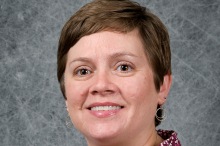 Suzanne Horsley is being honored as a Champion of Change for her service to the American Red Cross.
Suzanne Horsley is being honored as a Champion of Change for her service to the American Red Cross.
I am both humbled and honored to be chosen as one of the Champions of Change for helping to build more resilient communities. My experience in disaster responses has shown me that while the most horrible circumstances may bring out the best in people, individual and organizational preparedness is still the key to surviving a disaster. I am fortunate that my work as a public relations professor at the University of Alabama allows me to incorporate work for the public good in my teaching, research and service responsibilities.
My involvement in community service started early through 4-H Club projects and led me to organize an adult literacy tutoring program in college. After the September 11 terrorist attacks, I had a desire to find a job that mattered. I decided to go back to school to become a public relations professor and do research in crisis and disaster communication. During my academic journey, I have found a natural fit as a disaster public affairs volunteer with the American Red Cross. The training I have received and the experience I have gained by deploying to disasters has had a tremendous impact on my teaching, my research, and my approach to service learning in the classroom.
Learn more about ServiceBringing Nursing and Volunteerism Together to Help My Community
Posted by on September 14, 2012 at 11:58 AM EDT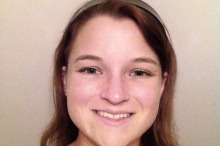 Stephanie Phillips is being honored as a Champion of Change for her service to the American Red Cross.
Stephanie Phillips is being honored as a Champion of Change for her service to the American Red Cross.
I am very honored to be recognized as a White House Champion of Change on behalf of the American Red Cross. I have my mom to thank for my connection with the Red Cross. She has influenced me in so many ways—in my nursing career, in my volunteer work, and in my involvement in my community as a whole.
I was 13 years old when my mom needed heart surgery. Because of an infection, she had two additional heart operations immediately after the first. At the time, no one told me that my mother was in such critical condition. I was allowed to visit her once in the hospital around Mother's Day. I only remember because I had made her a cake, and one of the nurses said that it was the one thing my mom had eaten in days. Later, my brother and I were told just how serious my mom's condition had been, and that she actually had died on the operating table. The medical care and the 12 units of blood she received during those operations are the reasons she is alive now.
Learn more about Service
- &lsaquo previous
- …
- 88
- 89
- 90
- 91
- 92
- 93
- 94
- 95
- 96
- …
- next &rsaquo

